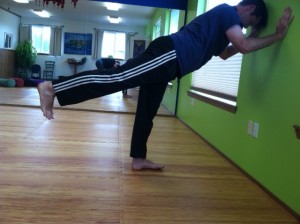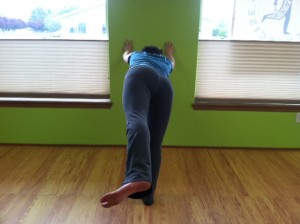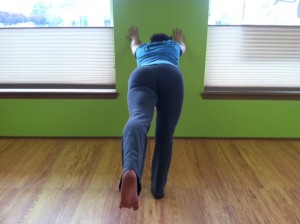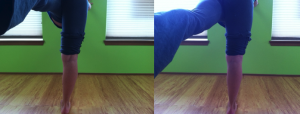This post from 2012 was updated in 2020 with some new images, light editing, and updated resources. For more information about how butt function is important to pelvic floor health, read Our Best "Healthy Pelvis" Resources.

I get a lot of emails about the butt. As in, "Where can I get one?" If I could sell a strong butt muscle online I would do it, but since I cannot, how about my favorite butt exercise instead? I used my favorite move in a workout I created for Prevention Magazine, but they only allotted 25 words to describe how to do it.
I can barely say my name in 25 words or less and this move is tricky; there are about 30 tiny details that should have been included to make sure you’re using your butt instead of other muscles.
Here are some expanded details:
1. Take off your shoes. In order to move your weight back into your glutes, you'll need to do this one barefoot.
2. Find a wall. And, P.S. don't email me for suggestions if you don't have "wall space." I don't have as much extra time as you imagine and all I'm going to tell you is to have a garage sale because you have too much stuff if you don't have enough wall space for your hands.
3. Put your hands on the wall. Ok, this is going to take too long breaking it down this way.
4. Make yourself look like this, only less hairy.
Now, you might think you look like the picture above, but check to make sure you don't actually look like this:
See how far forward the pelvis has moved over the foot? When your pelvis drifts in front of your ankle, you'll be using the muscles in the feet and on the front of the leg to hold you rather than those in the back. To move your glutes, you'll need to back your hips up until your pelvis is behind your ankle. Push your hands into the wall to help you move back.
Also, don't worry about lifting the back leg really high; the work is being done in the back of the standing leg. Focus on that leg most.
Lift your toes (see picture above) as an easy way to make sure you are back far enough.
Once you've figured out how to move back (and maybe you have to work on this for awhile), there's even more alignment points you need to hit in order to use the glutes and hamstrings most:
1. Hip Check. Is one higher than the other?
In the picture above, you can see that the floating side of my pelvis is higher than my standing hip. Lower the floating side of the pelvis as much as possible (pictured below).
You don't need a mirror, just take it as low as it goes. You'll feel an increase in work on the standing leg as you come down.
2. Are you collapsing against the wall? No bent elbows sagging, keep your arms long and strong. If you need to back up a bit, then do so, but remember your hips should be just behind your heels and your arms straight. Eventually, you won't need the wall as much; your standing leg will be strong enough to hold you. Look ma, no hands!
3. Your standing thigh should be neutral, not internally rotated (click on the picture to make it larger).
In the picture on the left my thigh has rotated inward. I've externally rotated to fix it in the picture on the right. Anatomically speaking, your hamstrings should be located behind your thigh, but when you rotate your bones, you also take their muscles with you. On the left, not only are my "knee pits" off to the side, my hamstrings went there too, thus, they can't work to hold me up. When they're like this, I'm using my ligaments in the knee and hip to hold me (ow, ow, ow). On the right, I'm using my hip and glute muscles. Yay!
4. Is your standing knee bent?
We often bend our knees to deal with our lack of strength and balance in the leg as a whole. It's a natural coping mechanism, but allowing the knee bend in this move will prevent you from improving your glute and hip strength, and keep you using the front of your leg. You might be wobbly with a straight leg, but feeling and dealing with the wobble is what allows your larger glute and hamstring muscles to respond and get stronger.
Work to keep your leg straight with a relaxed patella (see the Kneecap Release exercise on our Movement Multivitamin, in Move Your DNA or in Dynamic Aging). Don't force your knee back with your quads; rather use the muscles on the back of the leg to gently pull the bend out. When your quadriceps relax, your patella (kneecap) will lower down.
Finding the glutes and hamstrings with your leg straight is much more beneficial to helping these muscles fire in every-day tasks like standing, walking, and picking stuff up. Any part of you that depends on the glutes and hamstrings for stability and leverage (knees, hips, sacrum, pelvic floor) can benefit from this exercise.
Take this move and do it a few times throughout the day. Work up to holding it for a minute (really watching your form). You might find you have to add body part alignments one at a time, to give yourself time to get stronger in each area.
You can find more moves like this in our Virtual Studio classes and in our Nutritious Movement Improvement course. Read more about alignment in general in Move Your DNA and lower body alignment in Whole Body Barefoot. Find more exercises for pregnancy here and the pelvic floor here.








